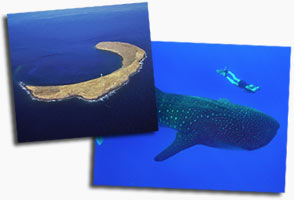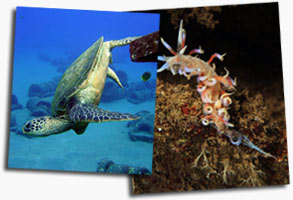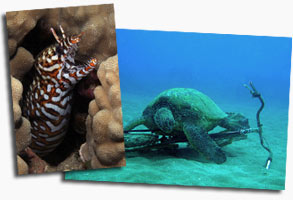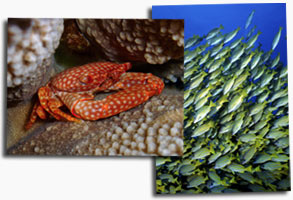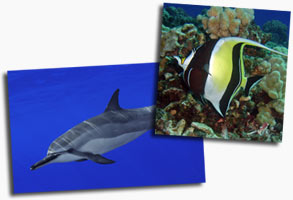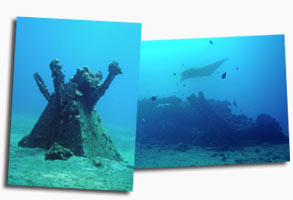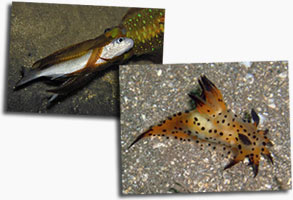
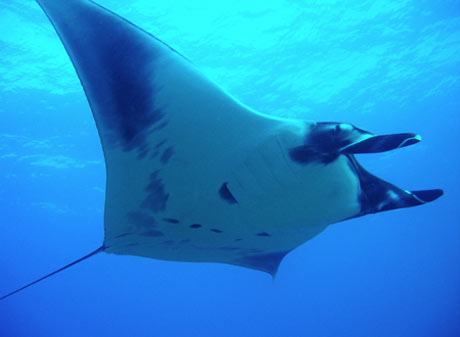
Maui Scuba Diving Sites
Mike Severns Diving Services
For the most wonderful Maui scuba diving sites possible, dive sites are always determined when we get out on the water in the morning so that we can see the wind, current and visibility, and so that we can find out from you what you are hoping to see. We often have scuba divers who are diving several days with us and so we also do our best to dive different Maui scuba diving sites during those days.
Typically, the first dive is someplace at Molokini, and the second dive is someplace off of Maui, with many scuba diving sites to choose from off either island. There is no way to predict a particular Maui scuba diving site even one day in advance because the wind might not do what is predicted, or we could get to a spot and see that the current is too strong or that visibility is horrible, etc. What we’ve found over the years is that divers are much happier diving sites that are good for that particular day, than they are diving a “guaranteed” site in unfavorable conditions.
Maui Scuba Diving Sites
One of the most interesting things we have learned is that Maui scuba diving sites change over time. An animal may stay for a few months and then disappear! Below are a few of the Maui scuba dives and sites that we visit with a description of the animals that we typically see there. Who knows what will be at what particular dive site when you visit?
Molokini Crater and Back Wall
A fifteen minute boat ride away, the little volcanic islet of Molokini offers some of our most exciting and visually stunning Maui scuba dives. A volcano sitting on a three hundred foot bottom, it provides all kinds of scuba diving for a range of diver abilities. It is here that we are most likely to see pelagic animals…
The St. Anthony Dive
The sinking of the St. Anthony, a 65-foot longliner, in October of 1997, marked the latest addition to South Maui’s only official artificial reef. Construction of the reef off Mokapu Beach in Wailea began in 1962 with the sinking of 150 old automobiles, but the combination of thin car metal and saltwater reduced this potential reef to…
Kihei to Makena Dive
This area along the southwest coast of Maui is on the leeward or protected side of Maui and was of course home to a large Hawaiian population before European contact, as evidenced by rock house sites on land and stone fishing sinkers underwater. The bottom is generally a very gradually sloping sand…
85 ft. Pinnacle Dive
When Europeans discovered the Hawaiians Islands in 1700s, Polynesians had been calling them home for 1,000-1,500 years. Evidence of these years of habitation exists not only on land but underwater as well in the form of fishponds and well-known fishing sites. The 85 ft. Pinnacle is one of the few known pre-contact…
La Perouse Bay Dive
This scenic bay is a recent creation in Maui’s geologic history, formed when the last lava flowed on Maui about 200 years ago. It is located well away from human development and the view from the boat is of a gorgeous, undeveloped Hawaiian mountainside. It’s a view not many visitors get to see. This dive has an amazing variety…
WWII Objects Dive
During WWII the Navy, Marines and the Army all trained on Maui. Underwater demolition teams were trained off Kihei and amphibious maneuvers were practiced all the way from Maalaea to Makena. An airstrip on Maui’s isthmus was used to train carrier-based pilots. At least eight amphibious tractors (LVTs) and several airplanes …
Muck Diving
Some of the most unusual and interesting animals live in a habitat that divers call “muck.” If you’re tired of coral, clear water and brightly colored fish, then this is the place for you! We would dive here more if we could, but we only have the pleasure when we get a curious group that is clamoring for something really different…
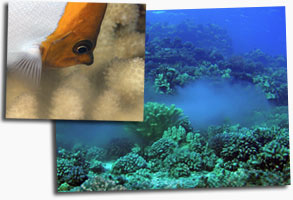
Coral Spawning Dive
Several times a year, on specific days, we take a few scuba divers out to see something very special called coral spawning. One way that corals reproduce is by releasing eggs and sperm into the water at an uncannily exact time, using the moon phases and the time of sunrise and sunset. Over the past 21 years we have…

